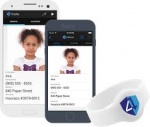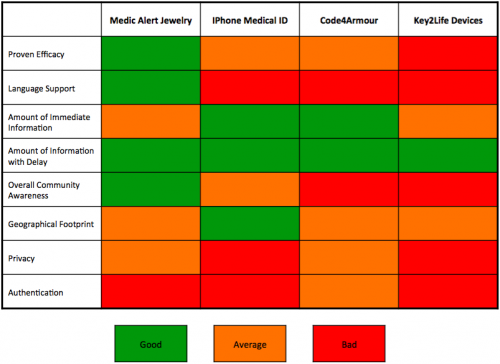Projects:2015s2-211 Health Visa
Contents
TEAM
Group Members
- Samuel Zevenbergen.
- Mingjie Qiu.
Supervisor
Client (Canadian)
BACKGROUND
There are an increasing number of people living with serious allergies, medical conditions and specific treatment wishes without the means of communicating this with First Responders and Paramedics in an emergency situation. There have been many situations where poor outcomes such as avoidable injury or death have resulted from medical treatments administered by medical professionals in emergency situations due to a lack of patient medical history.
The purpose of patient care/healthcare is for medical professionals to use their knowledge and experience as well as all available medical information and advanced directives to make a prompt and competent diagnosis leading to appropriate and correct treatment during a medical emergency. Currently it is in the patient's best interest to ensure they can communicate relevant medical information in case of an emergency. It is also the medical professional's obligation to respond in the correct manner to any medical information and reasonable wishes 07/19/ignoring-a-medic-alert-bracelet 1.
EXISTING SYSTEMS
Currently there are many devices and systems, which can be used by patients to communicate their treatment critical information with medical professionals in the case of emergency where they are unable to.
Despite the current number of options available, there are still cases where speed of access to information, amount and accuracy of information, language barriers, privacy, authentication, security, community awareness and location of the information have resulted in undesirable outcomes such as medical episodes and even death.
In response to this issue, a number of systems have been created, each with weaknesses around the amount of information available, time required to access information, data privacy and/or security. The below sections highlight the pros and cons of each system.
There are a number of systems available for people to communicate their medical details and treatment wishes with first responders. These include: Medic Alert (jewelry), Medical ID (Apple Inc.), Code4Armour and Key2Life systems. Each of these is described below in regard to their efficacy, language support, access requirements, amount of immediate/delayed information, community awareness, geographical footprint as well as privacy and authentication.
Medic Alert
Overview
The Medic Alert Foundation was founded in California in 1953, but now has affiliates in 9 other countries. They are the only non-profit organisation that hires ‘highly skilled medical response personnel’. They offer a range of jewelry (bracelets, anklets and necklaces) with medical information, treatment wishes and ID number engraved on them. To get a medic alert tag, you must purchase the jewelry online, create an online profile, specify details to be engraved and pay an annual subscription fee, which are all dependent on the country you live in. If your medical information changes, you have to purchase a new tag or pay for your current one to be smoothed and re-engraved (which can only be done once or twice).
Pros
- MedicAlert has a proven efficacy.
- Significant language translation service available.
- Good community awareness of the system.
- Significant geographical footprint (9 countries in total).
Cons
- Small amount of immediately available information (only what is engraved on the bracelet).
- There is an extensive delay to obtain further medical information (relayed via phone or fax).
- The system lacks privacy as anyone can access your medical records by reading them off your bracelet.
- There is no authentication required to access the initial information (from your bracelet).
iPhone Medical ID
Overview
Many people have a contact labelled ‘ICE’ - ‘In Case of Emergency’ on their phone, but they have a passcode, which disables anyone from accessing it in an emergency. Apple has developed a medical ID application, which can be enabled on any iPhone with a minimum of iOS-8 installed. This allows anyone to access your medical information such as allergies, blood type and medications as well as your emergency contact details. It also allows them to use your phone to contact your emergency contacts, even if your phone is locked.
Pros
- The amount of information immediately available is significantly greater.
- Exists on a popular phone.
- Significant geographical footprint.
Cons
- There efficacy of this system has not been proven.
- No language translation support.
- Minimal community awareness.
- This system is lacking privacy.
- No authentication required in order to access medical records. No record of someone accessing your records.
Code4Armour
Overview
Code4Armour is a new technology in which you buy and wear a passive bracelet on your wrist. To set this up, you pay an annual subscription fee, create an online account and upload your personal, medical and emergency contact details. Anyone with a Near Field Communication (NFC) capable phone and the free Code4Armour™ app can bring up your details on their phone by scanning your bracelet. There are two types of people (general users and first responders who must be verified).
Pros
- The amount of information immediately available is significantly greater.
- Exists on popular devices.
Cons
- There efficacy of this system has not been proven.
- No language translation support.
- Minimal community awareness.
- There are specific hardware and software requirements in order to access records.
- This system is lacking privacy.
- No authentication required in order to access medical records. No record of someone accessing your records.
Key2Life
Overview
Key2Life is an emerging company offering many medical ID devices, from wearable USB sticks, tags with NFC technology, and cards with magnetic strips and/or QR codes. These systems generally require a once off payment for purchase, with no recurring subscription costs. In a medical crisis where you may be unable to speak for yourself, civilian laypersons and medical physicians can access your information from a computer or a smartphone with NFC/QR reader capabilities. There are some evident hardware and software requirements in order to access the information stored in these devices.
Pros
- The amount of information immediately available is significantly greater.
- Geographical footprint is large, but user base is small.
Cons
- There can be a significant delay in order to access any information (you may need to plug a USB into a computer for example).
- There efficacy of this system has not been proven.
- No language translation support.
- Minimal community awareness.
- There are specific hardware and software requirements in order to access records.
- This system is lacking privacy.
- No authentication required in order to access medical records. No record of someone accessing your records.
Summary of Existing Systems
From the above summaries of current technologies, it should be clear that many of them are relatively complete, but have downfalls. The below figure is a diagrammatic comparison of the already discussed technologies and the completeness of features, which are most important for an efficient system like this. The key point to be made from this diagram is that all current existing systems have major privacy and authentication issues.



